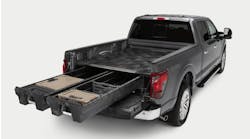Latest from Hydronics & Radiant
Sponsored
In recent years, hydronic radiant heating has gained marked traction in North America as a growing alternative to forced air heat in both residential and commercial building.
Comfort is often identified as the main reason why people choose to install radiant over forced air systems, although steadily escalating energy costs have brought efficiency to the top of the list of reasons why more contractors, homeowners and architects are selecting radiant heating systems.
A number of current market trends are contributing to a rising demand for radiant heating systems and the contractors capable of installing them. Energy efficiency is the key benefit, as radiant heating systems typically allow thermostats to be lowered as much as 4˚F compared with a forced air system, without sacrificing comfort, thus reducing fuel consumption and often yielding significant utility bill savings for the homeowner. In addition, a rising popularity in the use of geothermal heat pumps has also played a role, as these heat pumps have been found to work very effectively with radiant heating systems.
Ground-source heat pumps typically extract water at ideal temperatures for a radiant heating system: 110˚F to 120˚F. While the efficiency of geothermal systems can be slightly compromised when paired with forced air systems because they require additional energy to boost the water temperature, they are now seen as an efficient means of heating a home when integrated with low-temperature radiant heat. The efficiency advantage of radiant heating is even more significant in commercial applications, in which building designs typically feature high ceilings, high air infiltration and generally large amounts of space. In commercial applications, the reduced maintenance requirements of radiant heating are also attractive.
In addition, growth in both the custom and retirement home building markets has spurred increased demand for radiant heating systems.
As for retirement or “patio” homes — typically one-level slab-on-grade structures that, by design, require a concrete pour — radiant becomes an obvious choice. The structural nature of these “patio communities,” as they are sometimes called, lends itself to efficient installation of a radiant system at the initial stages of laying the foundation. The radiant system is also highly desirable to retiree residents from the perspective of the efficiency and comfort it provides.
Finally, the move towards green building is supported by radiant heating, which enhances not only energy efficiency, but also the quality of the indoor environment by providing comfortable temperatures, quieter operation and improved air quality.
Whether you’re a plumbing and mechanical contractor, or someone on the traditional forced air side of the fence, getting the radiant heating component of a business going can be as simple as following these three steps:
1. Learn the system. As current market demands underscore the likelihood that “if you build it, they will come,” it’s imperative that a contractor participate in formal training on radiant heating systems prior to specifying and installing them. You definitely want to get involved right away with a program in which instruction is provided on everything from the components of the system, to how to develop the design and calculations for different types of jobs, to actually installing it in a manner that ensures long-term reliability and overall customer satisfaction.
In this respect, training opportunities should be sought either through a reliable supplier of the full range of radiant heating system components (to garner a comprehensive understanding of how each works), or via a professional trade school. Numerous training opportunities are available through the Radiant Panel Association (www.radiantpanelassociation.org).
2. Use good product. When starting the radiant heating system portion of a business, the quickest way to establish credibility is by using quality system components. High-grade pipe, reliable fittings, a high-efficiency heat source and an easy-to-balance manifold are all very important, and beyond credibility they will lend peace of mind about long-term system performance. The last thing you want to be concerned with when you’ve put the reputation of your business out there is whether you’ve gone with the right product.
3. Partner with a supportive supplier. A contractor interested in entering the radiant heat business should make sure the chosen manufacturer not only offers a quality product, but also end-to-end product and system support. This includes comprehensive technical sales materials, a substantial distribution network, homeowner/ customer educat ion materials, design support, system design software, and even onsite installation support.
The choice of supplier applies also to the wholesaler, who can provide regionspecific knowledge and likely has radiant experts on staff who can offer additional help. It’s of vital importance that you select a supplier who can scale to your needs, (especially when starting out with radiant projects), and one that supports a network of manufacturers’ representatives who can even provide on-the-job installation training and support.
Building trends are already enhancing market demands, and in taking the right steps your radiant business can be up, running and capitalizing on them in a fairly short period of time. For more information on getting started, visit the RPA at www.radiantpanelassociation.org, or contact a system supplier directly.
Lance MacNevin, unit manager of Rehau Academy, is a nearly 20-year veteran of the radiant industry, and has trained contractors across North America. An engineer by trade, MacNevin was involved in the development of a number of radiant heating products in use today. He also works closely with a number of North American piping standards committees and trade associations. He can be reached at 703/777-5255. Additional information is available at www.na.rehau.com.

